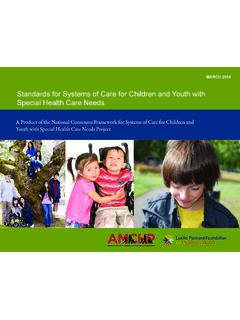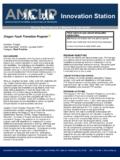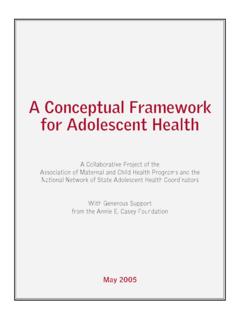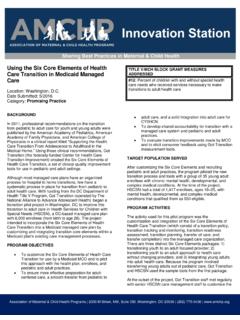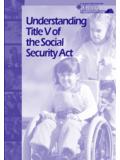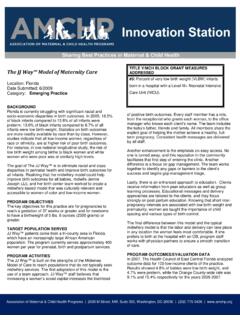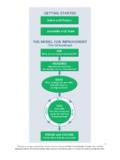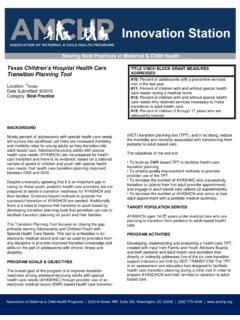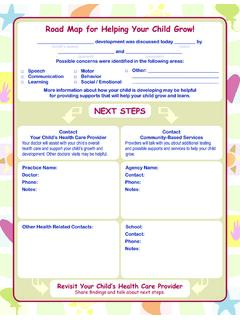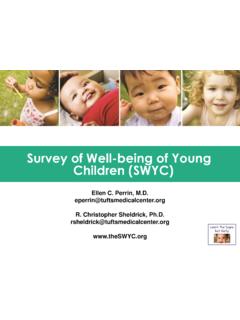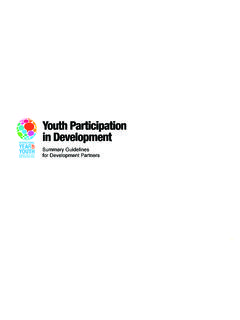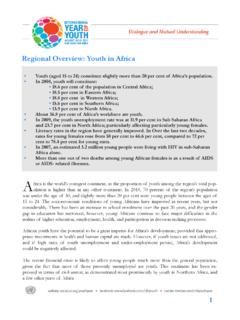Transcription of Late Adolescence/Young Adulthood (Ages 18 –24 years) for a ...
1 Adjust to new physical sense of self While young adolescents experience rapidand profound physical changes triggered byhormones acting on different parts of theirbody, physical and sexual body changes areprimarily most physical development iscomplete, young men may continue tophysically grow until age acceptance of physical to a sexually maturing body and feelingsWith the significant changes in adolescence, youth must adapt sexually and establish asense of sexual identity. This includesincorporating a personal sense of masculinityor femininity into one s personal identity;establishing values about sexual behavior;and developing skills for sexual with serious relationships andtheir potential for emotional and physicalintimacy (What kind of person am I?)
2 Whatkind of person would suit me best as apartner?).nSerious intimate relationships begin todevelop. Majority regard love, fidelity andlifelong commitment as very important to asuccessful are sexually and apply abstract thinking skillsAdolescents experience significant changes intheir capacity to think. In changing fromconcrete to abstract thought they areincreasingly able to understand and grapplewith abstract ideas, think about possibilities,think ahead, think about thinking, and putthemselves in another person s shoes. In general, this changes their ability to thinkabout themselves, others and the worldaround them. This is a gradual process that spansadolescence and young Adulthood . Forexample, early in the process youth arelimited in their ability to hold more than onepoint of view understanding somethingfrom one perspective but not for abstract thought becomesestablished; can think abstractly andhypothetically; can discern the underlyingprinciples and apply them to newsituations; and can think about the future,Although scientists have documented braindevelopment in adolescence and youngadulthood, they are less sure about what itmeans for changes in cognitivedevelopment, behavior, intelligence, andcapacity to age 6 (on average), a young person sbrain is 95% of adult size.
3 However, thebrain continues to physically develop in theteen years and even into the 20s with asecond growth spurt of gray matter(peaking at age 11 for girls and 12 for boys)followed by a pruning process in whichconnections among neurons in the brainthat are notused wither away and thosethat areused remain. The front part of the brain, responsible forfunctions such as complex reasoning,problem-solving, thinking ahead,prioritizing, long-term planning, self-evaluation and regulation of emotion,begins to develop in early adolescence witha final developmental push starting at age16 or 17. It is not that these tasks cannot bedone before young Adulthood , but ratherthat it takes more effort and Adolescence/Young Adulthood (Ages 18 24 years) This is a time of life when very little is normative.
4 It is a period of frequent changeand exploration that covers many aspects of their life: home, family, work, school,resources, and process of becoming an adult is more gradual and varied today than in thepast. Young people take longer to achieve economic and psychological autonomyand early Adulthood experiences vary greatly by gender, race and ethnicity, andsocial Development What is normal for a young adult?Where do they live?Who do they live with?In school?Working?Working and in school?In-between school and work?Unemployed?Close to parents?Parenting?Spouse or partner?Community member?Tax-payer?Voter?Citizen?consideri ng many possibilities and logicaloutcomes of possible to hold and manipulate clusters ofabstract ideas and create systems fororganizing abstract ability to consider different pointsof view at the same time can result inincreased empathy and concern for others,and new interest in societal issues for also allows youth to better value thediversity of people (and their perspectives)and appreciate that there may be manyright answers to a and AdolescenceSeeing Through A Developmental LensDevelopmental Tasks and Attributes of Define a personal sense of identityAdolescents move from identifyingthemselves as an extension of their parents(childhood) to recognizing their uniquenessand separation from parents.
5 They develop asense of self as an individual and as a personconnected to valuable people and groups. They refine their sense of identity aroundissues such as gender, physical attributes,sexuality, ethnicity. They explore issues suchas Who am I? How do I fit in? Am I loveableand loving? How am I competent? One result of this is experimentation withdifferent, temporary identities by means of alternative styles of dress, jewelry, music,hair, manner, and lifestyle. Teens maystruggle to identify a true self amid seemingcontradictions in the way they feel andbehave in different situations, and withdifferent levels of thought and understanding. nFirmer sense of identity, although still atime of identity exploration (especially inareas of personal relationships, education,work, family).
6 NAge of feeling in-between see themselvesas neither an adolescent nor an adult .Adopt a personal value systemAdolescents develop a more complexunderstanding of moral behavior andunderlying principles of justice. They questionand assess beliefs from childhood andrestructure these beliefs into a personalideology ( more personally meaningfulvalues, religious views, and belief systems toguide decisions and behavior).nDecisions and values are less influenced to see multiple viewpoints, value thediversity of people and perspectives andappreciate that there can be many rightanswers to a problem. nIdentify values and viewpoints that work foroneself while respecting viewpoints/valuesof othersRenegotiate relationship with parents/caregiversAdolescents negotiate a change inrelationship with parents that begins tobalance autonomy (independence) withconnection.
7 Overall, the adolescent s task isone of separating in some ways, whilemaintaining and redefining connections inothers, in order to make room for a moreadult relationship that meets culturalexpectations and provides necessary support. nImproved ability to see parents asindividuals and take their perspectives into with parents often decrease with in parent-child roles,especially for those who live at home(nearly half of all young adults in theirlate teens and early twenties still live withtheir parents). This is important asresidential change is highest in lateadolescent/young Adulthood than anyother age group (young people living athome, moving out and living independentlyor with peers/partners, moving back home,etc).
8 Develop stable and productivepeer relationshipsPeer relationships change during adolescenceto provide youth with more support andconnections as they spend less time withadults and in supervised relationships often compete with parentsand schools in influence on teen s attitudesand behaviors. As networks with peersbroaden, peer relationships become deeperand play an increasing role in shaping anindividual teen s self-concept and interaction. Adolescents experience three transformationsin peer relationships: 1. Reorientation of friendships from activity-based relationships of childhood to morestable, affectively oriented friendshipsbased on idea and value Growth of romantic and sexually Emergence of peer crowds. 2 This synthesis of adolescent development research wascompiled by K.
9 Teipel of the State Adolescent HealthResource Center, Konopka Institute, University of adolescence, friendships becomemore stable, intimate and supportive; theyprovide a cornerstone for learning about adultrelationships. nRelate to individual peers more than topeer mature style of peer relationships(stability, intimacy and supportiveness).nIncreasingly more balance between theinfluence of family and peers on the youngperson. Meet demands of increasing mature roles and responsibilitiesAdolescents gradually take on the rolesexpected of them in Adulthood . They learnthe skills necessary for these roles andmanage the multiple demands of the labormarket as well as meet expectations regardingcommitment to family, community to concern for level of concern for the about one s role in to work, college, independentliving.
10 participation in college education inyoung Adulthood is nonlinear frequentlycombined with work and periods of non-attendance in in general remain in school longerand marry later, but those from less-advantaged households find it harder toadhere to an orderly and predictablesequence of education, full-timeemployment, home-leaving, cohabitation ormarriage, and experiences become more focusedon laying foundation for adult occupationThe State Adolescent Health Resource Center is funded through Cooperative Agreement #U93 MC 00163-01 from the Maternal Child and Health Bureau HealthResources and Services Administration, Department of Health and Human Services.
